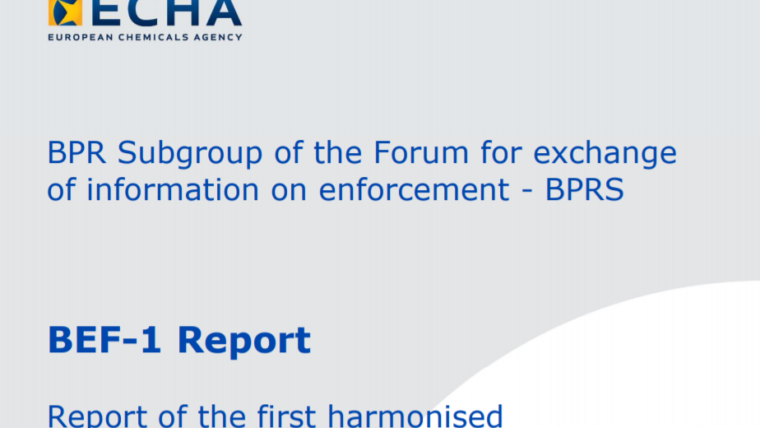EkotoxInfo 2/2022
Ekotox Centers
Ekotox Hungary Kft. (Hungary)
Ekotoxikologické centrum CZ s.r.o. (Czechia)
Centrum Ekotoksykologiczne Sp. z o.o. (Poland)
Ekotoxikologické centrum Bratislava s.r.o. (Slovakia)
February 2022
Ekotox Centers selection from EU chemicals and related legislation:
- Eight other substances proposed for authorization!
- An Act making it mandatory to report products in the SCIP database
- New obligations for manufacturers of reserved products applicable from 1 January 2022
- Four hazardous chemicals added to the Candidate Lis
- Public consultation on REACH revision launched
- Ongoing guidance consultation
- Updated SCIP candidate list package available
- Last call for REACH number for NONS notifications
- News on approvement of plant protection products
—————————————————————————————————————————————–
Eight other substances proposed for authorization!
ECHA invites comments on its proposal to include eight substances of very high concern in the REACH Authorisation List. Comments can be given by 2 May 2022.
ECHA considers recommending eight new substances below for the European Commission to include in the Authorisation List (Annex XIV to REACH).
The information will be passed on directly to the Commission and will not be considered by ECHA.
- Ethylenediamine (CAS: 107-15-3, EC: 203-468-6), respiratory sensitising properties
- 2-(4-tert-butylbenzyl)propionaldehyde and its individual stereoisomers (CAS: – EC: -), toxic for reproduction
- Lead (CAS: 7439-92-1 EC: 231 -100-4), toxic for reproduction
- Glutaral (CAS: 111-30-8 EC: 203-856-5), respiratory sensitising properties
- 2-methyl-1-(4-methylthiophenyl)-2-morpholinopropan-1-one (CAS: 71868-10-5 EC: 400-600-6), toxic for reproduction
- 2-benzyl-2-dimethylamino-4′-morpholinobutyrophenone (CAS: 119313-12-1 EC: 404-360-3), toxic for reproduction
- Diisohexyl phthalate (CAS: 71850-09-4 EC: 276-090-2), toxic for reproduction
- Orthoboric acid, sodium salt (CAS: 13840-56-7 EC: 237-560-2), toxic for reproduction
If a substance is included in the Authorisation List, it can only be placed on the market or used after a given date if an authorisation is granted for a specific use. Companies that are using, manufacturing or importing these substances can apply for authorisation.
An Act making it mandatory to report products in the SCIP database
On 1 November 2021, the Act of 30 September 2021 amending the Waste Act and certain other Acts entered into force.
The modification of the provision in question is related to ensuring the full transposition of Article 9(1)(i) of Directive 2008/98/EC of the European Parliament and of the Council of 19 November 2008 on waste and repealing certain Directives. It introduces an obligation for product suppliers (manufacturer or importer of a product, distributor or other actor in the supply chain who places a product on the market) to report data on substances of very high concern (SVHCs) in products when placing them on the market (https://echa.europa.eu/sk/scip).
This information is reported by product suppliers to the European Chemicals Agency in the SCIP database. Reporting the required information to the European Chemicals Agency complements the existing communication and reporting obligations for SVHC substances in products, as these data already have to be reported along the supply chain. The aim of the SCIP database is to ensure that information on SVHCs is available throughout the life cycle of products and materials, including the waste phase, and thus to make information available to waste handlers to enable them to identify and effectively treat waste containing substances of very high concern.
https://ekotox.eu/chemicals-management/
New obligations for manufacturers of reserved products applicable from 1 January 2022
Although Act No. 302/2019 on the back-up of disposable beverage containers and amending certain laws is already in force as of 1 December 2019, certain provisions are effective as of 1 January 2022.
The manufacturer of the reserved product is obliged to:
– before placing the reserved product on the market of the Slovak Republic, apply for registration in the Register of manufacturers of the reserved product.
– if he/she will fulfil the reserved obligations collectively, he/she is obliged to attach to the application a confirmation of the conclusion of a contract with the relevant producer responsibility organisation.
– a producer of batteries and accumulators who will fulfil the reserved obligations through a third party shall attach to the application a confirmation of the conclusion of a contract with the third party.
If the Manufacturer of the reserved product is not registered in the Register, it shall not place the products on the market of the Slovak Republic.
Four hazardous chemicals added to the Candidate List
The Candidate List of substances of very high concern now contains 223 entries for chemicals that can harm people or the environment (update on 17 January 2022).
One of the four substances is used in cosmetics and has been added to the Candidate List as it has hormone-disrupting properties in humans. Two are used, for example, in rubbers, lubricants and sealants, and have been included because they negatively affect fertility. The fourth is used in lubricants and greases and has been added as it is persistent, bioaccumulative and toxic, and therefore harmful for the environment. https://echa.europa.eu/authorisation-list
- 6,6′-di-tert-butyl-2,2′-methylenedi-p-cresol (CAS: 119-47-1, EC: 204-327-1)
Reason for inclusion – Toxic for reproduction (Article 57c)
- tris(2-methoxyethoxy)vinylsilane (CAS: 1067-53-4, EC: 213-934-0)
Reason for inclusion – Toxic for reproduction (Article 57c)
- (±)-1,7,7-trimethyl-3-[(4-methylphenyl)methylene]bicyclo[2.2.1]heptan-2-one covering any of the individual isomers and/or combinations thereof (4-MBC) (CAS: -, EC: -)
Reason for inclusion – Endocrine disrupting properties (Article 57f – human health)
- S-(tricyclo(5.2.1.02,6)deca-3-en-8(or 9)-yl O-(isopropyl or isobutyl or 2-ethylhexyl) O-(isopropyl or isobutyl or 2-ethylhexyl) phosphorodithioate (CAS: 255881-94-8, EC: 401-850-9)
Reason for inclusion – PBT (Article 57d)
Ekotox Authorisation webpages: https://ekotox.eu/reach-authorisation/
Public consultation on REACH revision launched
The European Commission, together with the Department for Environment and Development, has started work on the review of REACH as a result of the implementation of the Strategy for the Sustainable Development of Chemicals. In particular, it focused on:
– the protection of human health and the environment
– the use of animal testing
– the functioning of the internal market
– competitiveness and innovation of European industry and enterprises
The public consultation runs until 15 April 2022.
https://ec.europa.eu/environment/chemicals/reach/reach_revision_chemical_strategy_en.htm
 Ekotox REACH: https://ekotox.eu/reach-registration/
Ekotox REACH: https://ekotox.eu/reach-registration/
Ongoing guidance consultation
An amendment to ECHA’s Guidance on Information Requirements and Chemical Safety Assessment – Chapter R.7a, which takes into account the revised REACH Annexes, is being prepared this year. It is currently under comment. The amendment to the Guidance will modify the requirements for the determination of doses of substances for toxicity tests to ensure the safety of chemicals. This will prevent duplicate performance of tests.
![]() Ekotox Chemicals Safety Assessment: https://ekotox.eu/reach-registration/
Ekotox Chemicals Safety Assessment: https://ekotox.eu/reach-registration/
Updated SCIP candidate list package available
The SCIP candidate list package helps to create SCIP notifications including the new substances.
When providing information about Candidate List substances in the SCIP notification, it is need to use the IUCLID reference substance approach. Reference substances can be created in IUCLID, but now can be used SCIP package and import it to your IUCLID instance.
The updated SCIP Candidate List package includes:
- individual reference substance datasets;
- a change log of the Candidate List package;
- delta package reference substance datasets;
- and a list of reference substances.
![]() Ekotox SCIP: https://ekotox.eu/news/scip-database-duties-for-suppliers-producers-importers-and-distributors-of-articles-from-05-1-2021/
Ekotox SCIP: https://ekotox.eu/news/scip-database-duties-for-suppliers-producers-importers-and-distributors-of-articles-from-05-1-2021/
https://ekotox.eu/chemicals-management/
Last call for REACH number for NONS notifications
NONS (Notification of New Substances) was the procedure for registering chemical substances before REACH came into force. Existing NONS should be transferred to the newer REACH-IT system, which includes assigning a registration number to the relevant supplier. Companies that still want to assign a registration number to assigned NONS must do so before 17 July 2022 at the latest. After that date, claiming a registration number in REACH-IT will no longer be possible. ECHA will mark undeclared registration numbers in the ECHA database and on the ECHA website as invalid.
https://echa.europa.eu/support/helpdesks)
![]() Ekotox REACH: https://ekotox.eu/chemicals-management/
Ekotox REACH: https://ekotox.eu/chemicals-management/
News on approvement of plant protection products
Active substance phosmet – as active substance included in Annex I to Council Directive 91/414/EEC, approved under Regulation (EC) No 1107/2009 and listed in Part A of the Annex to Commission Regulation (EU) No 540/2011.
The approval of the active substance phosmet, expires on 31 July 2022.
On the basis of the assessment carried out by the Rapporteur Member State in collaboration with the European Food Safety Authority and the Commission, an unacceptable risk to operators, workers, bystanders and the general public has been identified, even with the use of personal protective equipment or the application of available mitigation measures. A high acute and chronic risk to consumers and aquatic organisms and a high risk to birds, mammals and non-target arthropods (including bees) have been identified. On the basis of this assessment, the approval of the active substance phosmet is not renewed.
Authorisations for plant protection products containing the active substance phosmet shall be withdrawn by 1 May 2022.
(COMMISSION IMPLEMENTING REGULATION (EU) 2022/94)
Active substance phosmet flumioxazin – as active substance included in Annex I to Council Directive 91/414/EEC, approved under Regulation (EC) No 1107/2009 and listed in Part A of the Annex to Commission Regulation (EU) No 540/2011.
The approval of the active substance phosmet, expires on 30 June 2022.
Flumioxazin is used as a herbicide to control serious plant health threats that cannot be managed by other available methods, including non-chemical methods.
Flumioxazin is classified under the Harmonized Classification as a Category 1B reproductive toxicant.
The Risk Assessment Committee (RAC) of the European Chemical Agency (ECHA) recommends that flumioxazin be classified as a Category 2 reproductive toxicant. Flumioxazin does not have endocrine disrupting properties.
Flumioxazin no longer meets the criteria for substitution pursuant to Article 24 of Regulation (EC) No 1107/2009. Flumioxazin is deleted from the Annex to Implementing Regulation (EU) 2015/408.
The period of validity of the approval of flumioxazin has been extended until 30 June 2022.
(COMMISSION IMPLEMENTING REGULATION (EU) 2022/43)
Purpureocillium lilacinum strain PL11
The period of approval of Purpureocillium lilacinum strain PL11 has been extended to 24 January 2037.
Member States must pay special attention:
- the strict maintenance of environmental conditions and quality control analysis during the manufacturing process to be assured by the producer, in order to ensure the fulfilment of the limits on microbiological contamination as referred to in the Working Document SANCO/12116/2012;
- the protection of operators and workers, taking into account that microorganisms are per se considered as potential sensitizers, ensuring that adequate personal protective equipment is included as a condition of use.
Conditions of use shall include risk mitigation measures, where appropriate.
(COMMISSION IMPLEMENTING REGULATION (EU) 2022/4)
————————————————————————————————————————————————————————–
Ekotox Centers provide support and consultancy for EU chemicals legislation and respective member states compliance 




